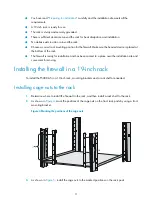
3
Temperature and humidity
Maintain appropriate temperature and humidity in the equipment room.
•
Lasting high relative humidity can cause poor insulation, electricity creepage, mechanical property
change of materials, and metal corrosion.
•
Lasting low relative humidity can cause washer contraction and ESD and bring problems including
loose captive screws and circuit failure.
•
High temperature can accelerate the aging of insulation materials and significantly lower the
reliability and lifespan of the firewall.
Table 1
Temperature and humidity requirements
Ambient temperature
Ambient relative humidity
•
Operating
0°C to 45°C (32°F to 113°F)
•
Nonoperating and storage
–40°C to +70°C (–40°F to +158°F)
•
Operating
10% to 95%, noncondensing
•
Nonoperating and storage
5% to 95%, noncondensing
Cleanness
Dust buildup on the chassis may result in electrostatic adsorption, which causes poor contact of metal
components and contact points, especially when indoor relative humidity is low. In the worst case,
electrostatic adsorption can cause communication failure.
Table 2
Dust concentration limit in the equipment room
Substance
Concentration limit (particles/cu m)
Dust particles
≤
3 x 10
4
(No visible dust on desk in three days)
NOTE:
Dust particle diameter
≥
5
μ
m
The equipment room must also meet strict limits on salts, acids, and sulfides to eliminate corrosion and
premature aging of components, as shown in
.
Table 3
Harmful gas limits in an equipment room
Gas Max.
(mg/m
3
)
SO
2
0.2
H
2
S 0.006
NH
3
0.05
Cl
2
0.01
Содержание SecPath F5000-A5
Страница 119: ...109 Figure 83 Fiber cabling example...

































